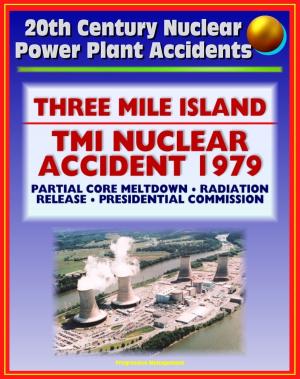2011 Nuclear Power Plant Sourcebook: Iodine-131 Radioisotope, Radiation Health Effects and Toxicological Profile, Medical Treatment with Potassium Iodide, Fukushima Accident Radioactive Release
Nonfiction, Health & Well Being, Health, Ailments & Diseases, Social & Cultural Studies, Political Science| Author: | Progressive Management | ISBN: | 9781458156945 |
| Publisher: | Progressive Management | Publication: | March 15, 2011 |
| Imprint: | Smashwords Edition | Language: | English |
| Author: | Progressive Management |
| ISBN: | 9781458156945 |
| Publisher: | Progressive Management |
| Publication: | March 15, 2011 |
| Imprint: | Smashwords Edition |
| Language: | English |
Iodine-131, a radioisotope with significant health implications that can be generated by nuclear power plant accidents and meltdowns, is fully covered in this authoritative, 600 page collection of official documents with details about the health and medical impacts of this dangerous fission product. Traces of iodine-131 were detected coming from the damaged reactors at the Japanese Fukushima Power Station in March 2011. A complete toxicological profile of iodine-131 from the Agency for Toxic Substances and Disease Registry (ATSDR) is included. There is also full coverage of a drug, potassium iodide, that is used to block the uptake of thyroid radioiodine, reducing the risk of thyroid cancer in populations at risk.
A large amount of epidemiological literature exists on the health outcomes in populations that were exposed to environmental releases of radioiodine. These include releases from explosions of nuclear bombs such as the Marshall Islands BRAVO test, the largest U.S. detonation (15 megatons), and from the Nevada Test Site; releases from nuclear fuel production facilities such as the Hanford Nuclear Site; and accidental releases from nuclear power plants such as the Chernobyl explosion and fire. In general, releases of these types result in mixed exposures to a variety of radioisotopes and to radiation doses from both external and internal exposure. However, doses from radioiodine that are significant to health derive largely from internal exposure as a result of uptake of relatively short-lived radioiodine isotopes into the thyroid gland. Thus, effects on the thyroid attributable to radioiodine that were subsequently observed, in some cases, years after the event, derived from exposures to the relatively high levels of radioiodine found immediately after the event, rather than from sustained exposures.
Potassium iodide is a salt, similar to table salt. Its chemical symbol is KI. It is routinely added to table salt to make it "iodized." Potassium iodide, if taken in time and at the appropriate dosage, blocks the thyroid gland's uptake of radioactive iodine and thus could reduce the risk of thyroid cancers and other diseases that might otherwise be caused by exposure to radioactive iodine that could be dispersed in a severe nuclear accident. Potassium iodide is a special kind of protective measure in that it offers very specialized protection. Potassium iodide protects the thyroid gland against internal uptake of radioiodines that may be released in the unlikely event of a nuclear reactor accident. The purpose of radiological emergency preparedness is to protect people from the effects of radiation exposure after an accident at a nuclear power plant. Evacuation is the most effective protective measure in the event of a radiological emergency because it protects the whole body (including the thyroid gland and other organs) from all radionuclides and all exposure pathways. Administering KI can be a reasonable, prudent, and inexpensive supplement to in-place sheltering and evacuation.
This is a privately authored news service and educational publication of Progressive Management.
Iodine-131, a radioisotope with significant health implications that can be generated by nuclear power plant accidents and meltdowns, is fully covered in this authoritative, 600 page collection of official documents with details about the health and medical impacts of this dangerous fission product. Traces of iodine-131 were detected coming from the damaged reactors at the Japanese Fukushima Power Station in March 2011. A complete toxicological profile of iodine-131 from the Agency for Toxic Substances and Disease Registry (ATSDR) is included. There is also full coverage of a drug, potassium iodide, that is used to block the uptake of thyroid radioiodine, reducing the risk of thyroid cancer in populations at risk.
A large amount of epidemiological literature exists on the health outcomes in populations that were exposed to environmental releases of radioiodine. These include releases from explosions of nuclear bombs such as the Marshall Islands BRAVO test, the largest U.S. detonation (15 megatons), and from the Nevada Test Site; releases from nuclear fuel production facilities such as the Hanford Nuclear Site; and accidental releases from nuclear power plants such as the Chernobyl explosion and fire. In general, releases of these types result in mixed exposures to a variety of radioisotopes and to radiation doses from both external and internal exposure. However, doses from radioiodine that are significant to health derive largely from internal exposure as a result of uptake of relatively short-lived radioiodine isotopes into the thyroid gland. Thus, effects on the thyroid attributable to radioiodine that were subsequently observed, in some cases, years after the event, derived from exposures to the relatively high levels of radioiodine found immediately after the event, rather than from sustained exposures.
Potassium iodide is a salt, similar to table salt. Its chemical symbol is KI. It is routinely added to table salt to make it "iodized." Potassium iodide, if taken in time and at the appropriate dosage, blocks the thyroid gland's uptake of radioactive iodine and thus could reduce the risk of thyroid cancers and other diseases that might otherwise be caused by exposure to radioactive iodine that could be dispersed in a severe nuclear accident. Potassium iodide is a special kind of protective measure in that it offers very specialized protection. Potassium iodide protects the thyroid gland against internal uptake of radioiodines that may be released in the unlikely event of a nuclear reactor accident. The purpose of radiological emergency preparedness is to protect people from the effects of radiation exposure after an accident at a nuclear power plant. Evacuation is the most effective protective measure in the event of a radiological emergency because it protects the whole body (including the thyroid gland and other organs) from all radionuclides and all exposure pathways. Administering KI can be a reasonable, prudent, and inexpensive supplement to in-place sheltering and evacuation.
This is a privately authored news service and educational publication of Progressive Management.















